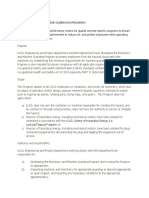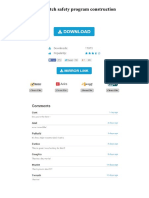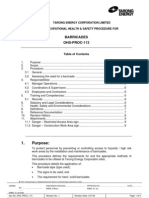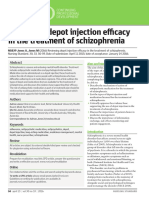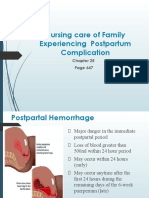Electrical Safety Manual - 2
Electrical Safety Manual - 2
Uploaded by
MarianoCopyright:
Available Formats
Electrical Safety Manual - 2
Electrical Safety Manual - 2
Uploaded by
MarianoOriginal Description:
Copyright
Available Formats
Share this document
Did you find this document useful?
Is this content inappropriate?
Copyright:
Available Formats
Electrical Safety Manual - 2
Electrical Safety Manual - 2
Uploaded by
MarianoCopyright:
Available Formats
Electrical Safety in the Workplace
Course Goal The aim of this program is to provide comprehensive on-site training to high-risk workers (i.e.
skilled trades and maintenance workers) and management on the requirements of Sub Part S, and the prevention
of serious injuries from electrical hazards at their worksites. Participants will develop understanding of the
requirements of OSHA Sub Part S and NFPA, 70E and will be able to identify and reduce or eliminate
electrical safety hazards in their workplace. Electrical Safe Work Practices including electrical safety principles,
guidelines for qualification of personnel, job planning requirements and Management and Personal
Responsibility will be covered.
Section
1
Content
Introduction to
Electrical Safety
Identifying the
Hazards
OSHA
Requirements
Safety Related Work
Practices
Objective
Participants will be able to:
Explain the issues (statistics) associated with poor electrical safety in the workplace.
Recall key electrical terms which are essential to understanding and meeting the
requirements of key electrical safety standards; i.e. OSHA 29 CFR 1910.331-.335,
NFPA 70E, NEC (NFPA 70)
Define and differentiate between qualified and unqualified persons under OSHA
Sub Part S. and the training requirements for each.
Describe the intent of an Electrical Safety Program and list the essential elements of
an effective program.
Use a Status Check survey to assess the facilitys electrical safety program and
where necessary develop strategies for improvement.
Participants will be able to:
List types of electrical hazards to personnel and describe the nature of the hazards
related to:
o Electric shocks, arcs and blasts
o Fault current and potential difference
o Electrical safety in industrial plants
List the characteristics of an arc flash hazard
List the characteristics of an arc blast hazard
Explain how other injury hazards are related to shock, flash, and blast
Participants will be able to:
Identify requirements specified in OSHA 29 CFR 1910.301-.308 and NFPA 70E2004 Chapter 4 and describe similarities and differences in OSHA and 70E.
Explain how NFPA 70E is used in OSHA compliance and enforcement.
Determine training for workers in accordance with OSHA Sub Part S requirements.
Recall Safe Installation Practices including:
o Guarding
o Identification
o Flexible cords and cables
o System grounding
o Location of overcurrent protection devices
o Workspace clearance requirements
Assess an electrical installation for compliance with OSHA regulations.
Explain the reasons for doing a site assessment to determine arc flash hazard
potential for equipment and electrical enclosure.
Participants will be able to:
Identify requirements for electrical safe work practices specified in OSHA 29 CFR
1910.331-.335 and NFPA 70E Chapter 1
Define an Electrically Safe Work Condition and list specific steps to be taken to
ensure an electrically safe work condition.
Explain how the creation of an electrically safe work condition can involve hazards
Electrical Safety in the Workplace
and the methods to protect against them.
Describe the facilitys lockout/tagout (LO/TO) procedure including requirements
and activities in the procedure and identify the persons responsible for each activity.
Determine the LO/TO procedure applicable to a given facility, operation, equipment
or activity.
Describe other safety related work practices to protect from electrical hazards
including:
o Selection and use of work practices
o De-energized work practices
o Energized work practices
o Approach boundaries and approach distances
o Requirements for use of test instruments and equipment
o Requirements for insulated tools
o Other equipment such as ladders, barricades, signs
5
Working On or Near
Live Parts
Participants will be able to:
Identify persons who may be exposed to a source of electrical energy directly or
indirectly.
List the conditions under which hot work is allowed.
Describe the purposes of an energized electrical work permit.
Recall three types of approach boundaries and define the dimensions of each
approach boundary, given all necessary information.
Describe the essential parts of a Flash Hazard Analysis and list the data required
analysis.
List the information, including Hazard Risk Category, provided to a worker by a
Flash Hazard Analysis and describe its use.
Personal Protective
Equipment (PPE)
Participants will be able to:
List the basic types of personal protective equipment (PPE) for tasks involving
electrical hazards.
Describe how each type protects against hazards and identify the limitations of PPE.
Explain the need for flame resistant (FR) clothing and layering of clothing for
protection and list clothing prohibited where electrical hazards are present.
Select PPE for a given Hazard Risk Category including gloves, eye, head, face
protection and (FR) clothing.
Describe the requirements for use, care, maintenance and storage of PPE.
Action Planning and
Course Wrap-up
Participants will be able to:
Outline an Action Plan to achieve compliance with OSHA Subpart S and NFPA
70E.
Provide assistance to help achieve workplace goals of OSHA Subpart S and NFPA
70E compliance.
You might also like
- PLE 2019 Legal Medicine & Ethics Questions and AnswersDocument23 pagesPLE 2019 Legal Medicine & Ethics Questions and Answersdickson100% (15)
- 2023 (DRAFT) HESU Integrated Monitoring and Evaluation ToolDocument21 pages2023 (DRAFT) HESU Integrated Monitoring and Evaluation Toolcharles nikko sabinoNo ratings yet
- Safety Legislation, Regulation and PolicyDocument110 pagesSafety Legislation, Regulation and PolicyNichoNo ratings yet
- Breaking Lines, Isolating and Release of EquipmentDocument69 pagesBreaking Lines, Isolating and Release of Equipmentanubiseth100% (1)
- J420V06 enDocument4 pagesJ420V06 enMarianoNo ratings yet
- SSEI EnglishDocument1 pageSSEI EnglishSunil ShrivastavNo ratings yet
- Machinery and Machine Guarding ProgramDocument35 pagesMachinery and Machine Guarding ProgramBenson Harison MajabeNo ratings yet
- Monthly Safety Inspection 2.3Document6 pagesMonthly Safety Inspection 2.3makaranthNo ratings yet
- HSE Alert 105-21 Welder Finger InjuryDocument2 pagesHSE Alert 105-21 Welder Finger InjuryAlecs NedeaNo ratings yet
- Unit 11 Elctrical Hazards ControlDocument42 pagesUnit 11 Elctrical Hazards Controlbabusureshdev5639No ratings yet
- LOTO FinalDocument35 pagesLOTO FinalRizwan KaziNo ratings yet
- Week 02 Electrical SafetyDocument1 pageWeek 02 Electrical Safetypl_rajaNo ratings yet
- 5.2 - Isolation of Energy SourcesDocument16 pages5.2 - Isolation of Energy SourcesarunNo ratings yet
- Permit Required Confined Space Checklist: CompletedDocument2 pagesPermit Required Confined Space Checklist: CompletedHarold Fernando Guavita ReyesNo ratings yet
- 5a Hazard ManagementDocument45 pages5a Hazard ManagementChoa Pei ShuangNo ratings yet
- 06 - HSE Alert Emergency Response - Electrical IncidentDocument2 pages06 - HSE Alert Emergency Response - Electrical Incidentmohammad_shahzad_iiuiNo ratings yet
- Automatic External Defibrillator (AED) Procedure Plan: Hutchinson Public SchoolDocument4 pagesAutomatic External Defibrillator (AED) Procedure Plan: Hutchinson Public SchoolidahssNo ratings yet
- Health, Safety and Environmental PolicyDocument5 pagesHealth, Safety and Environmental PolicyDOODS PALAONo ratings yet
- Safety Guidelines For Electrical High VoltageDocument6 pagesSafety Guidelines For Electrical High VoltageJeck SabarNo ratings yet
- Extension Cord ChecklistDocument3 pagesExtension Cord Checklistengrabbas75No ratings yet
- 51 General Safety Precautions in ConstructionDocument4 pages51 General Safety Precautions in ConstructionFazal Ahmed ShaikNo ratings yet
- Safety Behavior and Safety at Work Program DaraDocument3 pagesSafety Behavior and Safety at Work Program DaraSayed Saad ShehataNo ratings yet
- Intro Summary Main Findings and ConclusionDocument4 pagesIntro Summary Main Findings and Conclusionjimento0% (1)
- CGS Weekly Safety & Health Inspection ReportDocument1 pageCGS Weekly Safety & Health Inspection Reportတိုး ေဝ ေအာင္No ratings yet
- OSHA3767 Appendix DDocument33 pagesOSHA3767 Appendix Dgensai kNo ratings yet
- Toolbox Talk - Lightning StrikesDocument1 pageToolbox Talk - Lightning Strikessl1828No ratings yet
- CH 15-110 Heat Stress MGMT JUL14rev0914 PDFDocument20 pagesCH 15-110 Heat Stress MGMT JUL14rev0914 PDFSnaiderNo ratings yet
- PTW - Confined Space - ENDocument1 pagePTW - Confined Space - ENATSI HadjilaNo ratings yet
- Portable Fire Extinguisher RequirementsDocument5 pagesPortable Fire Extinguisher RequirementsPaige JonesNo ratings yet
- Isolation Certificate No.: Marafiq-Saur Operation & Maintenance CompanyDocument2 pagesIsolation Certificate No.: Marafiq-Saur Operation & Maintenance CompanyUsman ManiNo ratings yet
- 3.12 Hearing Conservation Program: HSE ManualDocument2 pages3.12 Hearing Conservation Program: HSE Manualvano0No ratings yet
- Niversity of Eicester: P W P R E & F M DDocument27 pagesNiversity of Eicester: P W P R E & F M DFOZCANNo ratings yet
- 10 Fire Risk Assessment For Small PremisesDocument27 pages10 Fire Risk Assessment For Small Premisesrukesh104No ratings yet
- Introduction To OSHA - NECCDocument68 pagesIntroduction To OSHA - NECCRangga Bhakty IskandarNo ratings yet
- AP Work Height SWPDocument30 pagesAP Work Height SWPfuazNo ratings yet
- ContractorSafetyManualCAN CSM PDFDocument308 pagesContractorSafetyManualCAN CSM PDFJerrod WolkowskiNo ratings yet
- Good Catch Safety Program ConstructionDocument3 pagesGood Catch Safety Program ConstructionStephanie0% (1)
- 0-WD010-MZ711-10002 HSE Work Permit Procedure - Rev.1 - PDFDocument11 pages0-WD010-MZ711-10002 HSE Work Permit Procedure - Rev.1 - PDFEdu TBNo ratings yet
- Assessment For Safety PDFDocument7 pagesAssessment For Safety PDFKokonok TektekNo ratings yet
- Powered Industrial Trucks ProgramDocument13 pagesPowered Industrial Trucks ProgramAndrea Del Pilar AyalaNo ratings yet
- Compressed Breathing Air: Industrial Hygiene Field Operations Manual Technical Manual NMCPHC-TM6290.91-2 12 MAR 2020Document11 pagesCompressed Breathing Air: Industrial Hygiene Field Operations Manual Technical Manual NMCPHC-TM6290.91-2 12 MAR 2020Abdus SamadNo ratings yet
- XXX Revised April 6, 2005 Standard Operating Procedure No. S-100Document12 pagesXXX Revised April 6, 2005 Standard Operating Procedure No. S-100Peter Nai HoNo ratings yet
- Ansi / Asse Z88.2: American National Standard Practices For Respiratory Protection (1992 Rev. Versus 2015 Rev.)Document5 pagesAnsi / Asse Z88.2: American National Standard Practices For Respiratory Protection (1992 Rev. Versus 2015 Rev.)Laurent Dumont100% (1)
- Trench SafetyDocument2 pagesTrench SafetyZeeshan BajwaNo ratings yet
- Activity3 - Electrical PrecautionsDocument10 pagesActivity3 - Electrical PrecautionsMOHD FAISALNo ratings yet
- Explosion Proof ClassificationsDocument2 pagesExplosion Proof Classificationsneurolepsia3790No ratings yet
- Coshh DepthDocument22 pagesCoshh DepthissaNo ratings yet
- HSInspectionsAtWork PDFDocument14 pagesHSInspectionsAtWork PDFMohammed YcfssNo ratings yet
- Gantry Crane PDFDocument2 pagesGantry Crane PDFcityofdarwingisNo ratings yet
- Ansi Safety SignDocument3 pagesAnsi Safety Signandy hamonanganNo ratings yet
- HSE Daily Insp Checklist (Format)Document1 pageHSE Daily Insp Checklist (Format)Mohammed YcfssNo ratings yet
- Problems With Safety Observation Reporting - A Construction Industry Case StudyDocument34 pagesProblems With Safety Observation Reporting - A Construction Industry Case StudyRadger Teddy ManuelNo ratings yet
- Magnetic Particle Inspection - Use and Implementation of ASTM-E-1444Document17 pagesMagnetic Particle Inspection - Use and Implementation of ASTM-E-1444jaga67No ratings yet
- Safety Alert - Elevating Work Platform Fatal AccidentDocument2 pagesSafety Alert - Elevating Work Platform Fatal AccidentNirmalkumarNo ratings yet
- Basic Electrical Safety: Group 4 Wooton Pagaran Pangda Escobido AbsueloDocument35 pagesBasic Electrical Safety: Group 4 Wooton Pagaran Pangda Escobido Absuelojefftboi100% (1)
- Confined Space EntryDocument61 pagesConfined Space EntryAlejandro LopezNo ratings yet
- Spill Response 7 StepsDocument11 pagesSpill Response 7 StepsIvan BaraćNo ratings yet
- Chemical SpillDocument33 pagesChemical SpillKodeChandrshaekharNo ratings yet
- Efpgc0702-Proc-Machine Guarding 6.11.07Document4 pagesEfpgc0702-Proc-Machine Guarding 6.11.07Yasser Hammad MohamedNo ratings yet
- Inspection Trade UnionsDocument35 pagesInspection Trade UnionsVenky Chowdary VankayalapatiNo ratings yet
- Work at Hight RegulationDocument12 pagesWork at Hight Regulationnight porterNo ratings yet
- OHS PROC 113 BarricadesDocument9 pagesOHS PROC 113 BarricadesPhillip L100% (1)
- Training: Course Tutors Are NVQ A1/D32/D33 QualifiedDocument1 pageTraining: Course Tutors Are NVQ A1/D32/D33 QualifiedAmeerUlHaqNo ratings yet
- One-Line Diagram Presentation: Etap Tip - No. 01Document1 pageOne-Line Diagram Presentation: Etap Tip - No. 01MarianoNo ratings yet
- Article 411: Confidential 15Document2 pagesArticle 411: Confidential 15MarianoNo ratings yet
- Confidential 3Document2 pagesConfidential 3MarianoNo ratings yet
- Rpsuredqwhgh7Udqvihuhqfld: Conserve Este Ticket Como Comprobante S.E.U.ODocument2 pagesRpsuredqwhgh7Udqvihuhqfld: Conserve Este Ticket Como Comprobante S.E.U.OMarianoNo ratings yet
- Electrical Safety Manual - 2Document1 pageElectrical Safety Manual - 2MarianoNo ratings yet
- National Electrical Code Nfpa 70 2014 Edition: Mike O'BoyleDocument2 pagesNational Electrical Code Nfpa 70 2014 Edition: Mike O'BoyleMarianoNo ratings yet
- Schedule For 2014 NEC: Confidential 5Document2 pagesSchedule For 2014 NEC: Confidential 5MarianoNo ratings yet
- Emerge Alliance: - Class-2 Ceiling Grid Distribution System by Armstrong World IndustriesDocument2 pagesEmerge Alliance: - Class-2 Ceiling Grid Distribution System by Armstrong World IndustriesMarianoNo ratings yet
- Online Version of Current NEC: 2F/www - Nfpa.org/onlinepreview/online - Preview - Document - Asp?id 7011SBDocument2 pagesOnline Version of Current NEC: 2F/www - Nfpa.org/onlinepreview/online - Preview - Document - Asp?id 7011SBMarianoNo ratings yet
- New Article 393: Low-Voltage Suspended Ceiling Power Distribution SystemsDocument2 pagesNew Article 393: Low-Voltage Suspended Ceiling Power Distribution SystemsMarianoNo ratings yet
- Estimation of The Zero-Sequence Impedance of Undergrounds Cables For Single-Phase Fault Location in Distribution SystemsDocument4 pagesEstimation of The Zero-Sequence Impedance of Undergrounds Cables For Single-Phase Fault Location in Distribution SystemsMarianoNo ratings yet
- CompareDPI UPS Book UsDocument1 pageCompareDPI UPS Book UsMarianoNo ratings yet
- Costestimatingsystemaace 208aDocument7 pagesCostestimatingsystemaace 208aMarianoNo ratings yet
- Engineer-Presentation 19, Quantities: TactDocument1 pageEngineer-Presentation 19, Quantities: TactMarianoNo ratings yet
- Sankosha (6.7)Document1 pageSankosha (6.7)MarianoNo ratings yet
- Consequence of An Unbalanced Supplying Condition On A Distribution TransformerDocument1 pageConsequence of An Unbalanced Supplying Condition On A Distribution TransformerMarianoNo ratings yet
- Purchasing Packages Bidders Rev E 7mar14Document3 pagesPurchasing Packages Bidders Rev E 7mar14MarianoNo ratings yet
- MV/LV Transformer Substations: Theory and Examples of Short-Circuit CalculationDocument1 pageMV/LV Transformer Substations: Theory and Examples of Short-Circuit CalculationMarianoNo ratings yet
- The Autism Strategy: Implications For People With Autism and For Service DevelopmentDocument8 pagesThe Autism Strategy: Implications For People With Autism and For Service DevelopmentLejandra MNo ratings yet
- Research ProposalDocument25 pagesResearch ProposaladerindNo ratings yet
- ULAT KAMBAL (Pishach Karpas) - Abroma Augusta: A Study On Its Pharmacological Actions From An Ayurvedic PerspectiveDocument7 pagesULAT KAMBAL (Pishach Karpas) - Abroma Augusta: A Study On Its Pharmacological Actions From An Ayurvedic PerspectiveIJRASETPublicationsNo ratings yet
- Mapeh 10 Exit AssessmentDocument7 pagesMapeh 10 Exit AssessmentGhia HernandezNo ratings yet
- Gary Elkins PH D CVDocument32 pagesGary Elkins PH D CVhouda houdaNo ratings yet
- Feu/clrs C FRM 05 Ver 00/eff 15nov2019Document93 pagesFeu/clrs C FRM 05 Ver 00/eff 15nov2019Cyril EstandarteNo ratings yet
- Negative Effects of Lead in Environment Ecosystems and Human Health (#169678) - 149694Document1 pageNegative Effects of Lead in Environment Ecosystems and Human Health (#169678) - 149694Neni RahayuNo ratings yet
- Up-Pgh Competency Program For New EmployeeDocument49 pagesUp-Pgh Competency Program For New EmployeeMichael SilvaNo ratings yet
- New India Mediclaim Policy Premium Chart-1Document2 pagesNew India Mediclaim Policy Premium Chart-1saiNo ratings yet
- Reviewing Depot Injection Efficacy in The Treatment of SchizophreniaDocument10 pagesReviewing Depot Injection Efficacy in The Treatment of SchizophreniaAnonymous raLgWVyqNo ratings yet
- Case 4 OBDocument6 pagesCase 4 OBcoosa liquorsNo ratings yet
- Orth Outh Niversity: Dr. Kais Zaman, PHDDocument40 pagesOrth Outh Niversity: Dr. Kais Zaman, PHDwasifNo ratings yet
- Ceiling Systems For High-Performing Health-Care FacilitiesDocument52 pagesCeiling Systems For High-Performing Health-Care FacilitiesFernando KatayamaNo ratings yet
- Doradiana,+a4 FActors+that+cause 61-76Document14 pagesDoradiana,+a4 FActors+that+cause 61-76Ainin SofiaNo ratings yet
- What is an IEP brochureDocument2 pagesWhat is an IEP brochuredarcie.badamiNo ratings yet
- SMLEQBank 7th - 27-12-15 PDFDocument527 pagesSMLEQBank 7th - 27-12-15 PDFIndrajit Barua100% (3)
- Human MicrobiomeDocument13 pagesHuman MicrobiomeHabab Ali AhmadNo ratings yet
- Medical Pluralism Theoretical Perspectives and Real Situation in Relationships With Public Health ViewpointDocument4 pagesMedical Pluralism Theoretical Perspectives and Real Situation in Relationships With Public Health ViewpointJames LoganNo ratings yet
- 2.1 NCM 210 RLE - Types of Family-Nurse ContactDocument6 pages2.1 NCM 210 RLE - Types of Family-Nurse ContactLYRIZZA LEA BHEA DESIATANo ratings yet
- Chapter 26 introduction to traumaDocument111 pagesChapter 26 introduction to traumaAjmal AbdulhameedNo ratings yet
- Revised Advertisement BMGF 29th October 2024Document6 pagesRevised Advertisement BMGF 29th October 2024bethueldaurai2016No ratings yet
- Day 10-11 - NCM 109 Lec - High Risk Post PartumDocument41 pagesDay 10-11 - NCM 109 Lec - High Risk Post PartumGrey KnighttNo ratings yet
- 4 LifeDocument10 pages4 LifederypriNo ratings yet
- The Relationship Between Speaking in English While Having An Oral Presentation To The Anxiety Level of The Grade 11 Students in Las Piñas City National Senior High SchoolDocument17 pagesThe Relationship Between Speaking in English While Having An Oral Presentation To The Anxiety Level of The Grade 11 Students in Las Piñas City National Senior High SchoolGui De OcampoNo ratings yet
- Understanding Good Mental HealthDocument10 pagesUnderstanding Good Mental HealthMike ReyesNo ratings yet
- Polysomnography - Wikipedia, The Free EncyclopediaDocument7 pagesPolysomnography - Wikipedia, The Free EncyclopediaPrashant KumarNo ratings yet
- Section 2 - Operational Standards: OS/05: Preparation of FoodDocument3 pagesSection 2 - Operational Standards: OS/05: Preparation of Foodmuhammed asharudheenNo ratings yet






